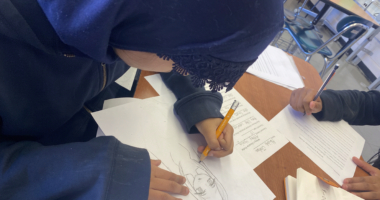
Interning at the The Young Women’s Leadership School (TYWLS) with Katie Rainey has been a wonderful experience. While I was in grade school, all girls’ schools were stigmatized as being drama filled and limiting. However, through my experience at TYWLS thus far, I am questioning my entire educational experience attending co-gender schools. As the only girl of four children, I constantly yearned for sisterhood. I realized attending a school like TYWLS would have been conducive to the determined and motivated type of student I was. TYWLS has shifted my conception of an all girls’ school, as there is a direct focus on leadership development and academic achievement. In addition, I noticed the significant role creative writing plays in fostering the affirming relationships and interactions between students.
As an undergraduate, I was a part of an artistic group called Urban Lyrics. The women of this collective provided a level of support I never witnessed between women. Through this support I developed self-awareness and vulnerability that allowed me to flourish as an individual and as a writer. It is evident that art can bridge differences, build solidarity, and sisterhood as I have witnessed in this classroom. The constant positive reinforcement and appraisal for one another as young women left me in awe, yet in such inspiration. Although, I cannot turn the hands of time I look forward to advocating for all girls schools for the upcoming generations in my family and students. TYWLS also brought to my attention the importance of school culture. It is vital that schools as an entirety create safe and encouraging environments that then trickles down to the interactions of students.

The students in this particular class are profoundly embedded in their emotions. The five minute free write provided in the beginning of each class is a time to reflect on one’s day, worries, or general thoughts. Based on the stories students share, the free write becomes the only space to share personal sentiments, struggles, and emotions. This is the major challenge of this class. How does one navigate and contain the level of “deepness” and therapeutic reality of writing while still remaining on track with outlined goals for the class? The free writes or poem these students share are written in prose without much creativity. They write just as they feel. How does one now shift reflection into creative writing in the span of 45 minutes when students are in need of safe spaces to heal? This is a question I am looking forward to developing solutions or alternatives to in the remaining weeks of the residency. Nevertheless, in this classroom I have heard deeply profound statements that have left me snapping and writing down quotes for personal reflection. I am extremely pleased with this residency and I look forward to interacting more with these brave and vulnerable writers.



